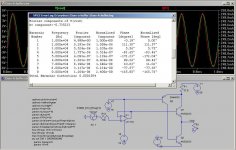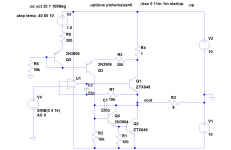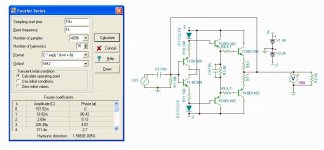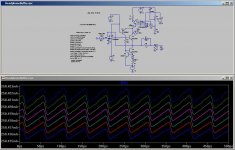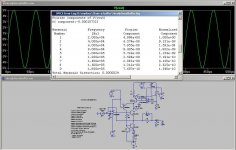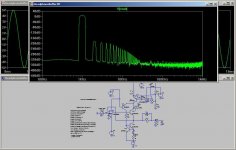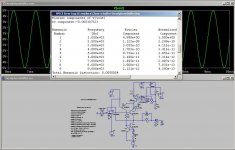I think you could help PSRR quite a lot if you reference V3 to the positive rail. That way, if the rail moves, the reference for the servod voltage across the resistor moves along with it.
www.updatemydynaco.com
www.updatemydynaco.com
Last edited:
Yes, but then there is the problem of the current through R1 drifting with temperature as the current is (V1 - Q3Vbe – V3)*R1. That’s another reason why in my first post I had the ccs. It makes things simpler. It dose not matter so much with a large value of R1 but we want to keep R1 very small to reduce dissipation.
Last edited:
Yes. but an emitter resp. source follower is 100% voltage feedback. Check this URL to understand this:I don't see any feedback from the output. I see a unity gain op amp driving an emitter follower with a constant current load.
Ultra low on resistance MOS-FET 2SK1595 classA single power amplifier
if the link don't goes open, check the attachment by
http://www.diyaudio.com/forums/solid-state/181050-will-work-grounded-source-darlington-4.html
latest version takes VbeQ3 pretty well out of the picture. Quiescent current changes about 33 mA out of 1000 mA from -40 to +80 C. A bit more reality added...compensation of the opamp loop.
Update My Dynaco
Update My Dynaco
Attachments
As far as I see, it's a kind of DC White Follower. A similar idea, a bit more sophisticated, was published by P.L. Taylor in Wireless World June 1973 :
An externally hosted image should be here but it was not working when we last tested it.
Agreed...they are very similar. do you have any more of the article that the picture comes from?
Constans (again)
It is even possible to keep both the voltage across the output transistor constant as well as the current through it. This results in a very low distortion buffer stage. I published this idea seven years ago on diyAudio:
http://www.diyaudio.com/forums/soli...ge-const-current-output-fet-2.html#post775787
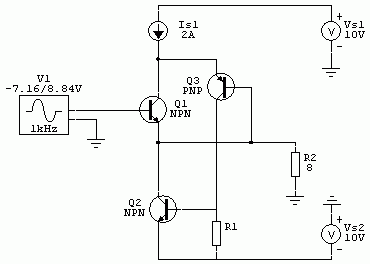
MikeB showed a version of it with JFETs that provides zero DC shift:
http://www.diyaudio.com/forums/solid-state/70745-simple-low-distortion-jfet-buffer.html#post803157

Even after all these years I never built a real (tangible) version of this circuit.
Cheers, Steven
It is even possible to keep both the voltage across the output transistor constant as well as the current through it. This results in a very low distortion buffer stage. I published this idea seven years ago on diyAudio:
http://www.diyaudio.com/forums/soli...ge-const-current-output-fet-2.html#post775787

MikeB showed a version of it with JFETs that provides zero DC shift:
http://www.diyaudio.com/forums/solid-state/70745-simple-low-distortion-jfet-buffer.html#post803157

Even after all these years I never built a real (tangible) version of this circuit.
Cheers, Steven
Agreed...they are very similar. do you have any more of the article that the picture comes from?
The article I have is in french and was published in the Revue du Son, November 1974.
If you'd like to read it, send me an MP with your email address.
Not sure it has been mentionned yet :
Taylor Source Follower
Last edited:
Inside of an op-amp feedback loop, driving a capacitive load (47nF), with added parts to prevent self destruction.
Now to layout a PC board.
Schematic, Distortion 1KHZ, FFT 1KHZ, Distortion 20KHZ, Current -40C to 80C.
Of course it will probably not work anywhere near these levels when built and probably require some tweaking.
Now to layout a PC board.
Schematic, Distortion 1KHZ, FFT 1KHZ, Distortion 20KHZ, Current -40C to 80C.
Of course it will probably not work anywhere near these levels when built and probably require some tweaking.
Attachments
Last edited:
Some resemblances with Sreten's circuits, but used in differential pairs
Van de Plassche, p56
L'tage d'entre de l'ampli -3- diffrentiels insolites (Hphastos)
enhanced common collector
L'tage d'entre de l'ampli -4- exprimentations complmentaires (Hphastos)
Van de Plassche, p56
L'tage d'entre de l'ampli -3- diffrentiels insolites (Hphastos)
enhanced common collector
L'tage d'entre de l'ampli -4- exprimentations complmentaires (Hphastos)
- Status
- Not open for further replies.
- Home
- Amplifiers
- Solid State
- What kind of feedback do you call this?
